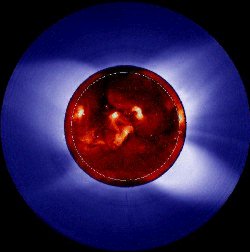This total solar eclipse in 1980 was photographed from Palem, India.
Click on image for full size
High Altitude Observatory and Rhodes College
High Altitude Observatory
Scientists at the
High Altitude Observatory (HAO) are working to understand the changes we see in the
Sun over time, and how these changes affect the atmosphere of the
Earth. There are four main areas of study at HAO.
Some people try to understand the structure of the inside of the Sun, and how it changes over time. They collect detailed information about the Sun, and try to learn about the basic physical processes that affect the interior.
Others focus on the magnetism of the Sun and the related events that we see near the surface. This research connects the study of the physical conditions in the interior with the activity in the hot gas above the surface.
Another group of scientists build instruments to observe the outer atmosphere
of the Sun, and try to understand the changes that we see over hours or even years.
Radiation and particles move out from the Sun, sometimes in sudden eruptions.
As the light and gas from the Sun reaches the Earth, others study the impact of the Sun's output on the magnetic field and atmosphere of our planet. This helps us protect satellites and astronauts, and teaches us how the Sun affects the global climate.
You might also be interested in:

To understand how our Sun works, it helps to imagine that the interior of the Sun is made up of different layers, one inside the other. The innermost layer, the solar core, is the region where the energy
...more
The Sun is not a quiet place, but one that exhibits sudden releases of energy. One of the most frequently observed events are solar flares: sudden, localized, transient increases in brightness that occur
...more
The visible solar atmosphere consists of three regions: the photosphere, the chromosphere, and the solar corona. Most of the visible (white) light comes from the photosphere, this is the part of the Sun
...more
IMF stands for Interplanetary Magnetic Field. It is another name for the Sun's magnetic field. The Sun's magnetic field is enormous and is carried by the solar wind. The solar wind and magnetic field are
...more
"Without warning, the relatively calm solar atmosphere can be torn asunder by sudden outbursts of a scale unknown on Earth. Catastrophic events of incredible energy...stretch up to halfway across the visible
...more
Scientists at the High Altitude Observatory (HAO) are working to understand the changes we see in the Sun over time, and how these changes affect the atmosphere of the Earth. There are four main areas
...more
Energy from the Sun is one of the primary drivers of the Earth system. The Sun warms our planet, heating the atmosphere. This energy feeds atmospheric processes and is a primary driver of our weather.
...more
The basic Hydrogen fusion cycle involves four Hydrogen nuclei (protons) and two electrons and yields a Helium nucleus, two neutrinos and six photons. This process occurs in three steps: the first one is
...more














